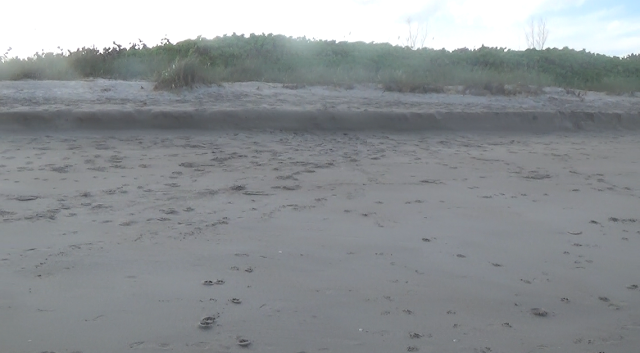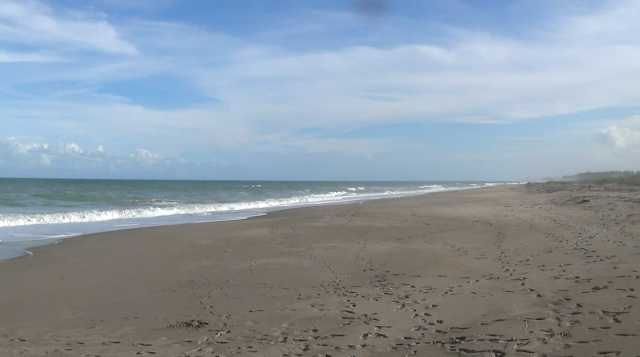Yesterday was an excellent day for observing how objects move on a beach. The surf was about three to five feet. That was rough enough that there were significant waves and enough force, while not too rough to be able to get close to the crashing waves. There were also lots of shells and small rocks. That made it possible to observe how things move.
At low tide I stood near the low point of the beach where the waves were crashing at the time. There were a lot of shells and things periodically exposed as the waves crashed and the water and sand came and went. Shells and things would be exposed, moved up and back down the beach, and then sometimes covered by sand again, and then exposed and moved again and again. Occasionally some were moved higher on the slope where they remained for a while.
I focused on one small roughly coin-shaped shell and watched the water rush back down the slope over that shell. At first it didn't move as the water rushed over it. No movement. No movement. Then all of a sudden it popped up off the sand, into the current and quickly retreated down the slope and disappeared into the swash.
The thing that struck me most about that observation is how quickly it popped up off of the sand and how quickly it moved after a period of hugging the sand and not moving as the water rushed over it.
Here is a quiz to see if you read my blog in the past. What have I called the point when the water force becomes sufficient to move a specific object?
It is the trigger point. And what I have just described is an excellent illustration. Again, what struck me was how sudden it was.
I think it is tempting to think that it is a more gradual process and that if the water is moving, objects are being moved in a similar way at and at similar rate. But water moves more gradually while objects being moved by the water can be moved not at all and then very suddenly. The trigger point is all or nothing. Eight it has been reached or it has not. Once the trigger point is reached and the object becomes suspended it moves very quickly until the what I have called the "settle point" is reached, and the object settles down on the bottom again.
Objects such as coins, which are relatively flat and settle against flat the surface, sometimes even settling slightly into the surface, move differently from round objects, which roll around - first up the beach and then back down. Rounder objects do not hug the surface and provide more surface area for the water to push against.
Flat coin-shaped objects quickly settle into the surface and do not provide much surface area for the water to push against, until they are lifted off the surface, and then they are moved quickly, sometimes flipping.
You can not observe how this works when the water is very rough. You can't stand in the crash zone when the surf is strong, and if you could you would still not be able to see small objects because the water is so rough and turbulent.
If you look at the illustration at the top of the post, the red area is where the waves were hitting with force and masses of shells were exposed. Occasionally they would get covered with sand and disappear, but often the sand was removed to expose the shells and rocks.
When a wave crashed, the water would dislodge settled objects and some of them would get washed up the slope. Many would get washed back down the slope with the returning water, but those that settled near the top (blue area on the illustration) formed a shell pile. Occasionally the water would hit the shell pile and wash some objects back down the slope.
This was all happening at low tide. As the tide gets higher, the crash zone moves up, as would other the surge and objects. At other times the shell pile might be pulled down into the water and disappear again.
All of this is very well explained by trigger points, and the increasing and decreasing water flow interacting with various characteristics of the objects, including density, size, shape and surface characteristics.
I was observing shells and rocks today, but coins are moved in a very similar way. Coin lines are formed in the same way as shell piles. You can't often observe the same process with coins though. There are much fewer coins, and they are more difficult to see. Shells will be moved slightly differently than coins, because of differences in density, size and shape, but the same basic principles apply.
I had plenty of other things to post today but thought I should post this while I was thinking about it.
Even when you are not finding what you want, take advantage of your time on the beach to observe how it all works. You might find something else in the process.
 |
| Remains of An Old Cut As Seen Yesterday Afternoon. |
 |
| One Formless Beach As Seen Yesterday Afternoon Near Low Tide. |
Every time I do try to catch a video of something in the crash zone, it seems things don't happen when I want.
It rained last night and much of today. The surf is down today and will be nearly flat for a few days.
I'll get back to recent finds in my future posts.
Happy hunting,
TreasureGuide@comcast.net
